Is Tallinn expensive? What are the costs of travel in Estonia?
I recently spent just under two days in the Estonian capital, and was curious about the costs as I knew it was supposed to be pricier than other Baltic countries!
So, I recorded all of my expenses to help other travellers to the country.
Here’s everything I spent and my thoughts!
Is Tallinn expensive?
Tallinn isn’t expensive per se, but prices are higher than in the other Baltic capitals and some Eastern European countries.
In recent years, the country’s tech boom means that it has developed quickly and prices have risen more so than elsewhere in the region.
However, it’s still cheaper than many capitals in Western Europe!
I was in Tallinn for just less than two days, and here’s everything I spent:
| €62.98 | Two nights in Capsule Hostels Tallinn |
| €6 | Tallinn Town Museum |
| €1 | Walking tour (booking fee) |
| €10 | Walking tour (tip for guide) |
| €6.3 | Coffee and pastry for breakfast |
| €19 | Lunch at a Georgian restaurant |
| €8 | Hot Aperol at the Christmas market |
| €6 | Glögg at the Christmas market |
| €4.6 | Food at a gas station |
| €3.8 | Coffee |
| €6.8 | Sandwich at Caffeine cafe |
| €3.9 | Bolt from the bus station to my hostel |
| €4 | Bolt from hostel to the city |
| €4 | 2 x tram journeys |
| €10.44 | FlixBus from Riga |
| €41.17 | Boat to Helsinki |
| €21 | Christmas market shopping |
| €2 | Laundry |
This came to a total of €220.99 for all my expenses in just under 48 hours in the city.
Cost of accommodation in Tallinn
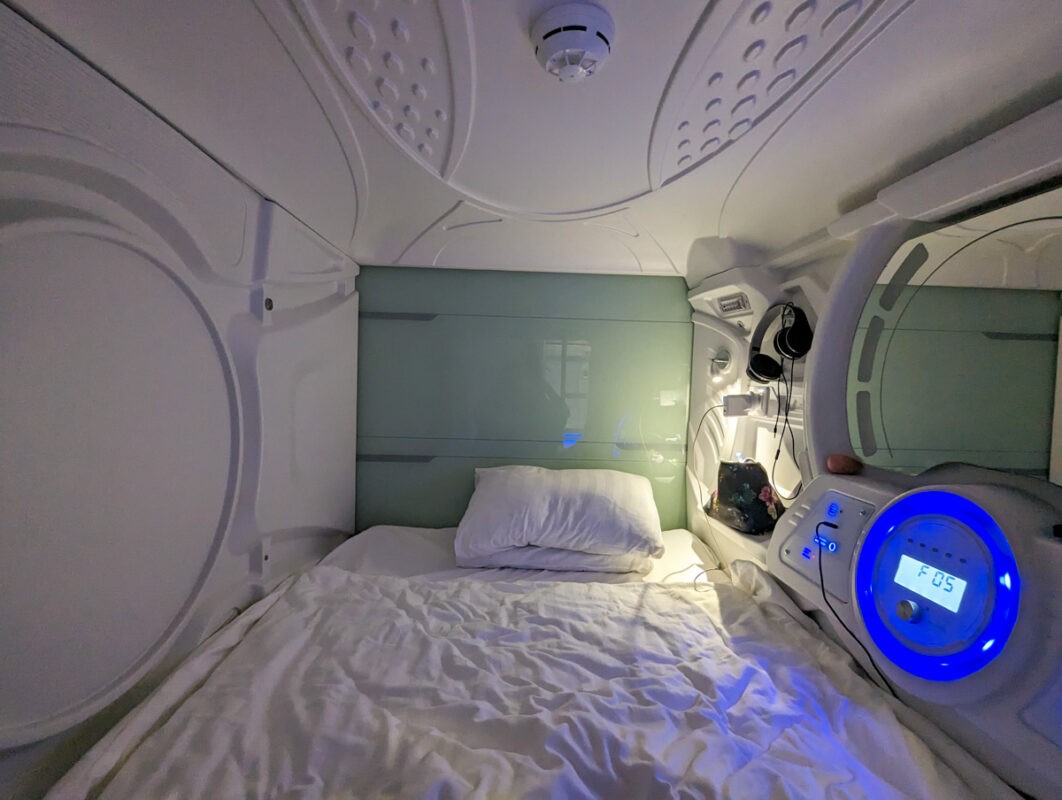
I stayed in Capsule Hostels Tallinn.
Now, while I stayed in many a hostel in my early and mid-twenties, I’ve long since hung up my hostel shoes. I’m in my 30s now, I’m working on the road, and I need a good night’s sleep!
But I decided to make an exception for Capsule Hostels Tallinn, as I quite enjoy a capsule hostel (having stayed in them in Singapore and Malaysia) and it was significantly cheaper than having my own room.
The stay cost me €62.98 for two nights, which seemed a bit steep for a capsule hostel, especially given that breakfast wasn’t included.
It also wasn’t in the city centre – it was a 40-minute walk or a quick 10-minute tram ride away.
The capsules were organized into separate rooms, giving off a slight hostel vibe which I wasn’t too keen on.
But I enjoyed it once I was inside my pod! I had my own space, unlike a hostel.
It was equipped with a comfortable mattress and various amenities like adjustable lighting, a plug, USB ports and a control panel for air circulation added to the comfort.
The shared bathroom facilities were ok but could be a little dirty – just like shared bathrooms can be!
There was a kitchen and lounging area, which were quite nice, although it was very quiet when I was there (which was fine for me – I wanted to get some work done!).
I also did some self-serve laundry at the hostel – it was only €2 but I put it on the wrong setting and it took four hours to wash and dry!
If I stayed again, I’d probably choose Citybox Tallinn City Center. This hotel has modern rooms and is between the port and Old Town (it’s a 15-minute walk to Tallinn Town Hall). Single rooms start at around €34 per night!
For some affordable luxury, Rixwell Collection Savoy Boutique Hotel is on the south side of the city centre and single rooms begin at €87 per night.
Cost of food and drink in Tallinn
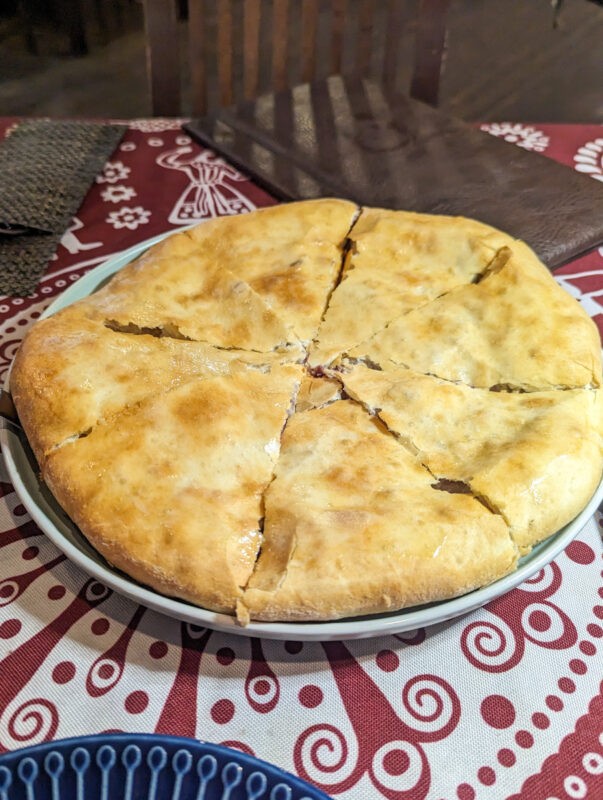
I spent a total of €54.50 on food and drink (including coffee and alcohol) in a day and a half in Tallinn.
First up was a coffee and pastry from Caffeine, my favourite Baltic coffee chain, which set me back €6.30 – notably more expensive compared to a similar breakfast I had in Riga, where the same combo cost just €3.30!
The quality was good, but the price difference was apparent!
For lunch, I dined at a Georgian restaurant Tbilisi, spending €19 on a lobiani (bean bread) and a tea. Initially, this felt pricey, but the bean bread was huge and very filling so I saved half for dinner.
Later on, I tried a hot Aperol from the Christmas market, which cost €8. It wasn’t quite as tasty as an Aperol Spritz – I think Aperol should be drunk in warm, sunny weather, but it was ok!
A standard glogg, the Estonian version of mulled wine, cost €6 and was tasty and warming. This was around the same as it cost in other Baltic markets.
For dinner, I had the rest of my Georgian bean bread and bought a bottle of juice, a protein bar, and a chocolate bar for €4.60.
I had the protein bar for breakfast the next day, and the chocolate and juice with dinner!
The next morning, I visited Caffeine for a morning coffee – which was €3.80 and ended up at the same cafe for a sandwich at lunchtime, which cost €6.80.
(I did like Caffeine, but obviously, there are plenty of other places to eat in Tallinn, too – just when I was out and about seeing the sights it always ended up being the best option!).
Cost of activities and attractions in Tallinn
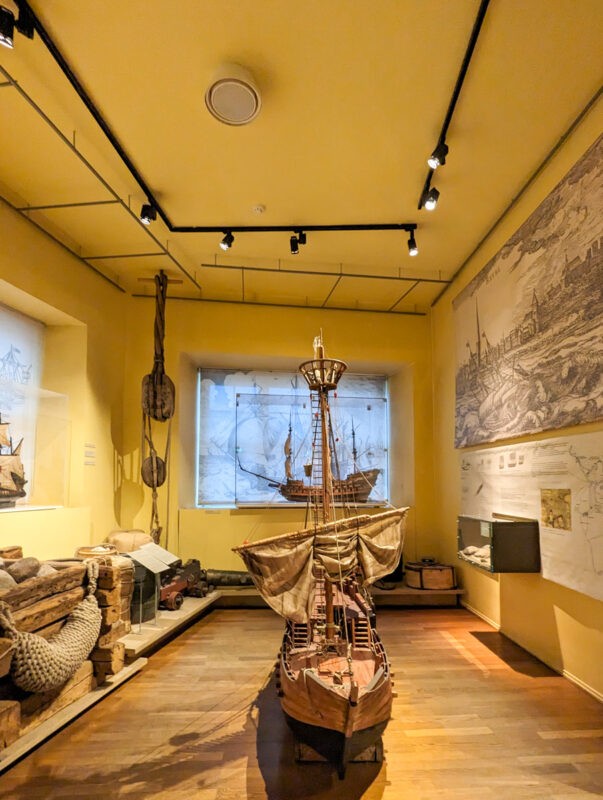
I spent €17 on attractions and activities in Tallinn, although I only went to one museum (and usually I go to at least two on my city breaks!).
The Tallinn Town Museum costs €6 to enter. It was a fantastic museum with lots of information on Tallinn’s fascinating history. Definitely recommend!
I also embarked on a walking tour with Tallinn in a Nutshell. Again, this was a wonderful way to discover the history and culture of Tallinn – my guide Kätlin was fantastic!
The tour cost me a nominal €1 booking fee, and I tipped Kätlin €10 for her excellent guidance and knowledge (tipping is expected, but it’s up to you how much you give – I usually do €10 if there are plenty of other people on the tour).
I also explored several of Tallinn’s attractions for free!
Walking around the Old Town independently on my second morning, enjoying a slice of solitude as the city woke up, was a highlight.
The Alexander Nevsky Cathedral is free (perfect for warming up in!) and is an interesting look at Estonia’s religious heritage (while Lutheran is the official religion of Estonia, Russian Orthodox is actually the most followed – but this is largely because most Estonians aren’t religious).
I took in the exterior of the imposing Toompea Castle and strolled through the Danish King’s Gardens; all of these parts of the Old Town give the essence of the city’s incredible, multi-faceted history.
Before I walked to the port (I was taking the ferry to Helsinki), I visited the Kalamaja neighbourhood (also for free).
This area is known for its bohemian vibe and artistic community, with street art and studios. It’s also where many of Tallinn’s start-ups are headquartered (Estonia is one of the most popular countries in the world for start-ups).
If you’re looking for more to do in Tallinn, here are a few activities on Get Your Guide that I liked the look of and the costs.
- From Tallinn: Day Trip to Lahemaa National Park – €109
- Best of Tallinn 2-Hour Bike Tour €31
- Tallinn Food Tour €120
- Coastal Cliffs and Rummu Submerged Quarry Day Tour €120
Is the Tallinn Card worth it?
The Tallinn Card, a pass for many of the city’s attractions and transport, could be worth purchasing if you’re planning on doing lots of museums and attractions and taking public transport.
Priced at €76.00 for a 3-day pass, it encompasses a comprehensive range of benefits that can enhance your visit to Tallinn.
One of the key attractions of the Tallinn Card is the inclusion of over 40 different attractions.
The card also includes public transport and substantial discounts on various tours, day trips, and other experiences.
These discounts can make some of the pricier activities more accessible.
Whether the Tallinn Card is worth it for you personally depends on your travel plans and interests – I’d recommend taking a look at what’s included and seeing if it lines up with what you want to do.
I decided against buying one myself as I didn’t have that long in the city, but it’s down to personal preference and needs!
Take a look at the Tallinn Card here.
Cost of transport in Tallinn
I spent a total of €12 on transport in Tallinn itself; I took two Bolt taxis and the tram twice. Bolt taxis were €4 each for a 10-minute drive and the tram was €2 per ride.
Bolt worked handily, especially when I first arrived in the city and was pushed for time, but if you’re visiting Tallinn on a budget, the trams are very easy to use.
I used contactless payment on the tram on the first day.
On the second day, I bought a ticket online and validated it upon boarding the tram.
I took FlixBus between the Baltic capitals. My 5-hour Riga to Tallinn bus cost €10.44 and was remarkable for its value.
Then, the boat trip to Helsinki cost €41.17. The ship was fantastic and I didn’t think it was too pricey for a two hour international journey.
Christmas market costs in Tallinn

In addition to the drinks, I spent an extra €21 at the Christmas market, buying a pair of thick woollen socks for my partner for Christmas (they were top of his list!) and a model of a traditional Estonian house for our flat.
Tips for saving money in Tallinn
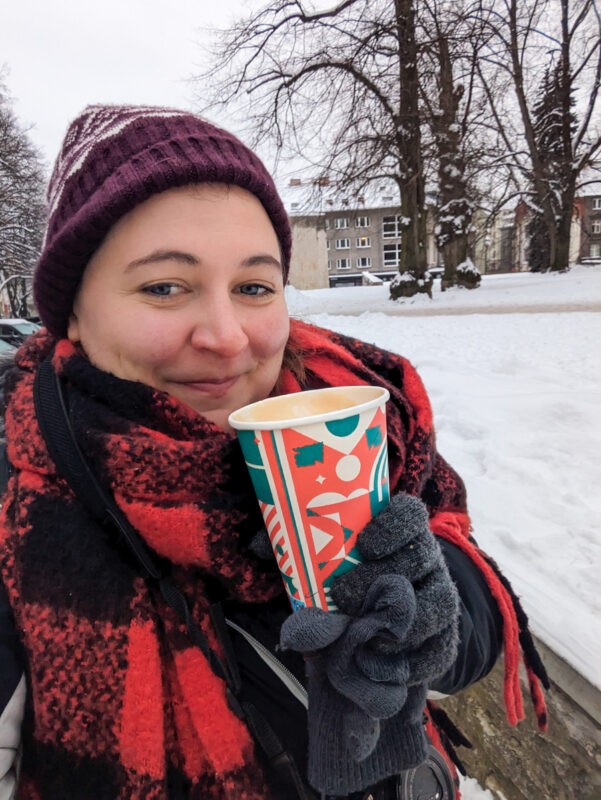
Here are my top tips for visiting Tallinn on a budget!
1. Stay out of the city centre
You’ll often find more affordable accommodation outside the Old Town.
Look for guesthouses, budget hotels, or hostels in neighbourhoods like Kalamaja, which is known for its bohemian atmosphere and historic wooden houses.
2. Consider a hostel or capsule hostel like I did
Look for budget-friendly accommodations like hostels – or choose the capsule hostel that I stayed at!
3. Favour free attractions
Many of Tallinn’s attractions are free.
Spend time wandering the Old Town, visiting the Alexander Nevsky Cathedral, or exploring the artistic Kalamaja neighborhood.
The Danish King’s Garden and Toompea Hill boast fantastic views without any cost.
4. Use public transport
Use Tallinn’s efficient public transport system to get around the city.
Trams and buses are affordable and cover most of the city. Consider buying a Tallinn Card if you plan extensive use, as it offers unlimited public transport and free entry to many attractions.
5. Find cheap eats
Avoid tourist-heavy areas for dining.
I’d recommend the street food market Balti Jaam for reasonably priced cuisine.
Also, many cafes offer affordable lunch specials on weekdays.
FAQs about the costs in Tallinn
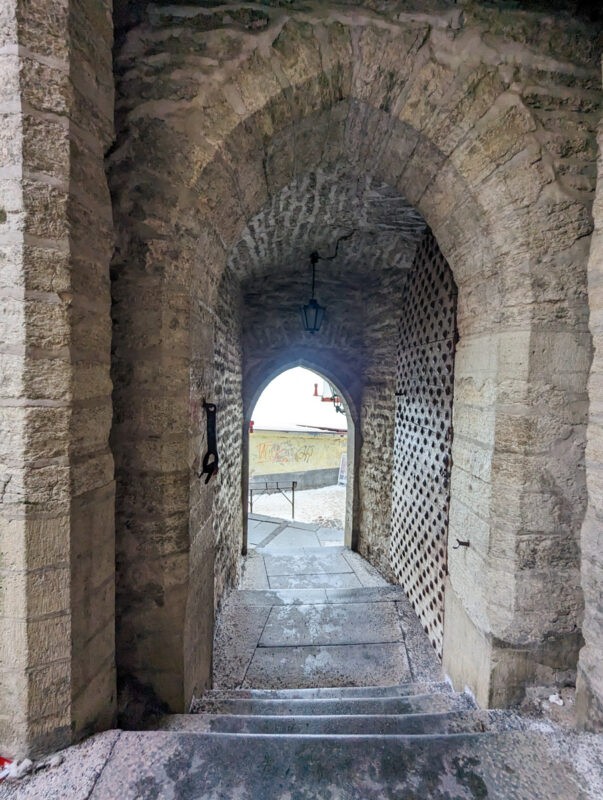
Here are some answers to frequently asked questions about prices in Tallinn!
How much does a meal cost in Tallinn?
In Tallinn, the cost of a meal varies.
A casual dining experience in a mid-range restaurant can range from €10 to €20.
For budget meals, like those in cafes or street food, expect to pay around €5 to €10.
How much is a pint of beer in Tallinn?
A pint of beer in Tallinn typically costs between €3 and €7, depending on the location and the type of beer. Pubs and bars outside the Old Town tend to offer lower prices.
Is Estonia cheap for tourists?
Estonia is relatively affordable for tourists, especially when compared to Western European countries.
Costs can be higher in popular tourist areas, but overall, it offers good value for money.
Is alcohol cheap in Estonia?
The price of alcohol in Estonia is moderate. It’s cheaper than in the Nordic countries but slightly higher than in some Eastern European nations. Expect to pay €3 to €7 for a pint of beer.
Is Riga or Tallinn more expensive?
Tallinn is generally a bit more expensive than Riga, especially in terms of accommodation and dining in tourist-centric areas. However, the price difference is not drastically high.
Is Vilnius or Tallinn more expensive?
Tallinn tends to be more expensive than Vilnius, particularly in terms of hotels and restaurants. However, both cities offer a range of options to suit various budgets.
Do I need cash in Tallinn?
Tallinn is extremely card-friendly – I didn’t use cash once when I was there. If you do need cash for any reason, there are plenty of ATMs.
Is Estonia more expensive than the UK?
Estonia, overall, is less expensive than the UK. Costs for accommodation, food, and entertainment are generally lower in Estonia compared to the UK.
How much is a cup of coffee in Estonia?
A cup of coffee in Estonia typically costs between €2 and €4, varying slightly based on the type of café and its location. Speciality coffee shops might charge a bit more.
So, what are the costs of travel in Estonia?
I didn’t think Estonia was expensive, but it certainly wasn’t the cheapest place I’ve been in Europe.
But I loved the history and culture, and think it’s definitely worth a visit!
If you’re doing some more research about visiting Tallinn, here’s my YouTube video from the city!

